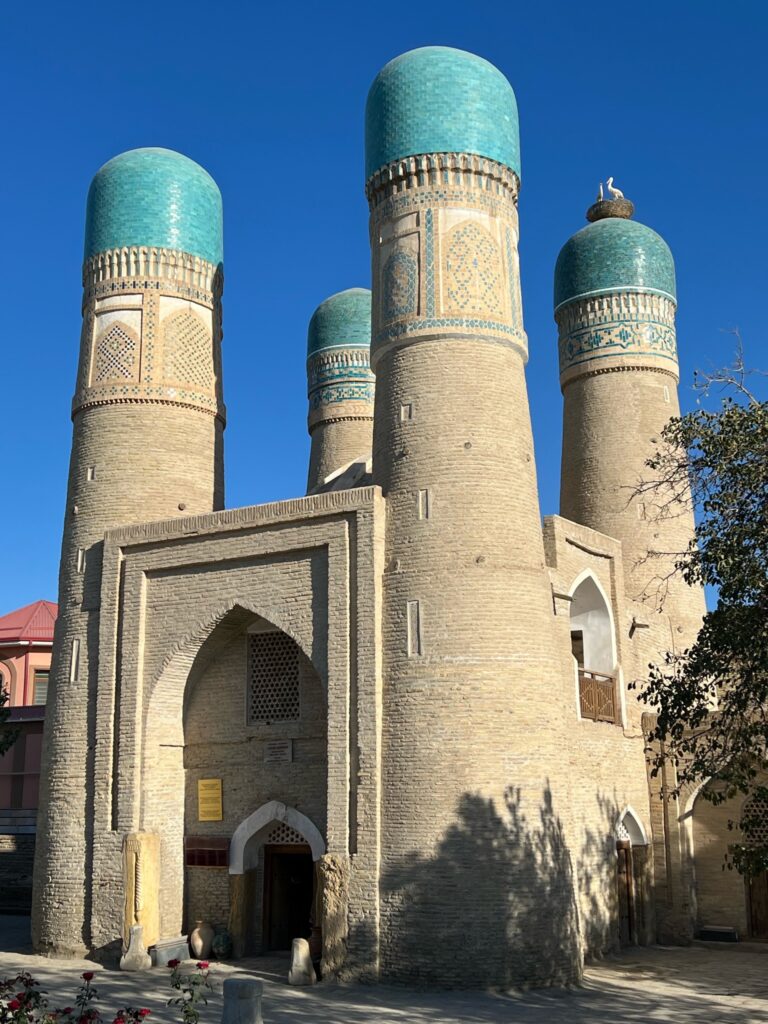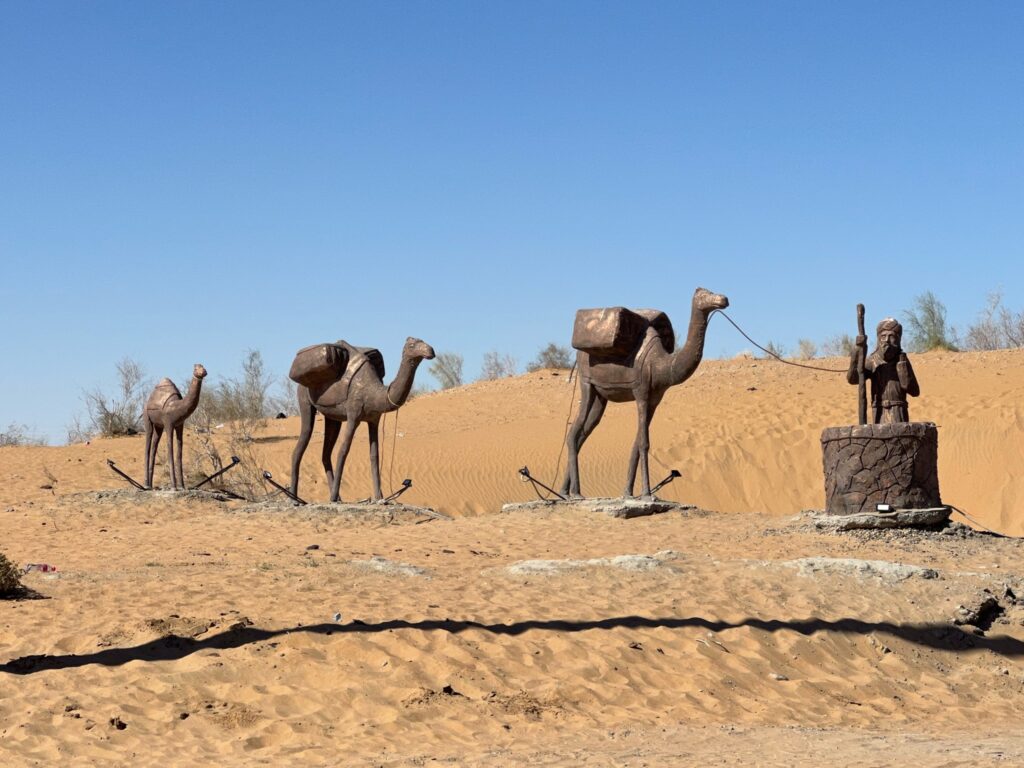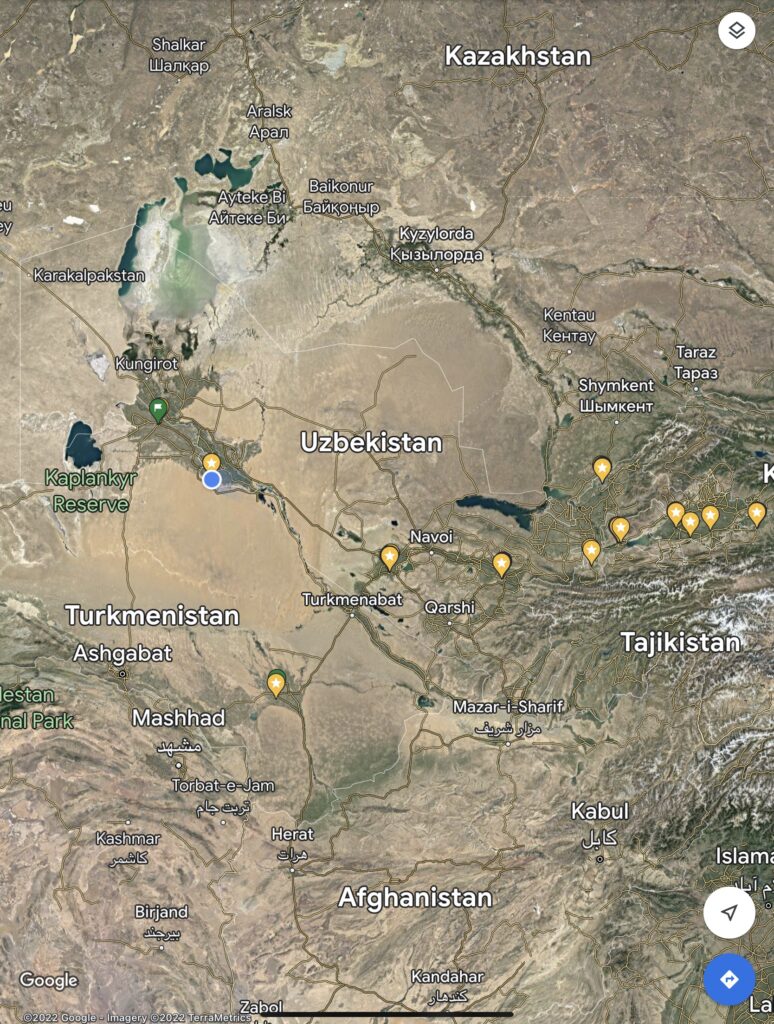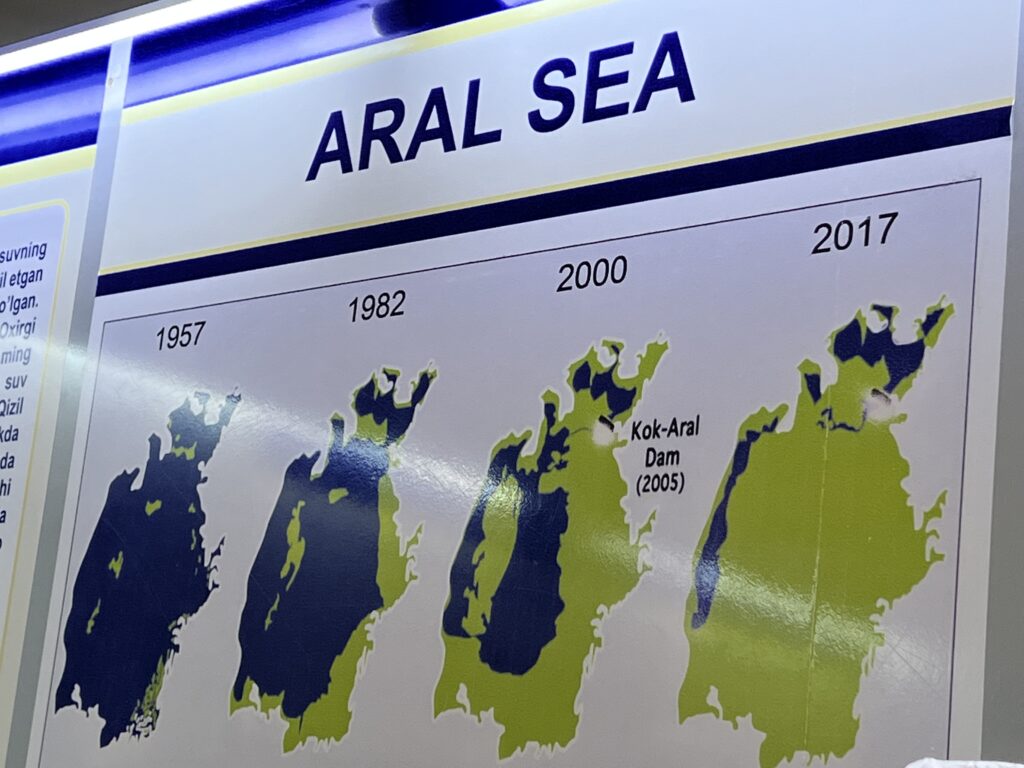1 October 2022
Mosques, madrasas, museums, meals, walks…it is becoming a blur. Don’t ask me where I was two nights ago and expect a quick answer. I drag myself into breakfast at a slower pace. I fruitlessly hope for a good cup of brewed coffee. There is always lunch just a few hours away so I won’t starve. It is another busy day learning about The Stans. I’m beginning to be thankful the original five became four.
Before leaving Bukhara, before facing our long, long drive across the deserts of Uzbekistan, we drive five minutes then are guided through a maze of little alley streets to a final mosque. It is a great site to start the morning.

Chor Minor Madrasa and Mosque is not an easy one to find weaving in and around tiny streets. It has its origin in the early 19th century. The exterior structure is atypical of what I have seen in Bukhara and that may be because it is more recent and built by a resident of Turkmen origin. There are four beautiful towers of varying design including elements which hint at Christian, Buddhist, Zoroastrian and Islamic motifs. The builder added four towers as he had four daughters and dedicated one to each. Each dome is ornamented with beautiful aquamarine tile shining in the morning sun. Atop one is a large stork nest with storks, fake, but favored for their luck. The interior of the mosque is typical for one of this region and now contains a gift shop.

Then the dreaded drive begins. We board our large, comfortable and air-conditioned bus and embark on the longest drive of our trip. A mix of very bad roads and new concrete stretches, desert, heat and wind will take us the 275 miles to Khiva. More facts about the countries of Central Asia, some napping, listening to a few podcasts, bathroom breaks that vary in smell and cleanliness, lots of arid land, sand and wind. We are surrounded by hundreds of miles of desert. I look for camels. My empathy rises for the thousands of caravans, men and camels, that crossed through this inhospitable land along the Silk Road.
There are small scattered villages and all traffic uses this one road traveling northwest from Bukhara. Large cotton fields are in varying stages of picking, all my women. I ask how they clear the fields after picking is done. They have several uses for the cotton plant. Sticks are used for firewood, seed and pods for oil. Leaves are ground for feed. Then the land is plowed and planted with another crop such as wheat.
Disagreements remain among the Stans as to their true boundaries. Since the Soviet break up and independence, there have been various border skirmishes and some brutal civil wars. While most are settled, a few remain between countries like Tajikistan/Kyrgyzstan. Some borders cause more problems than others because of their proximity to Afghanistan where the majority of illegal drugs originate. The poverty in Tajikistan encourages them to traffic drugs into neighboring Stans. Penalties for trafficking drugs are severe, though the cutting off of hands has stopped decades ago, at least here.
There seems to be pride in the fact that Uzbekistan supports a good relationship with others. However, it is a delicate dance keeping Putin happy. Putin warned Uzbekistan’s President that he could be on thin ice but currently I believe it’s Putin’s drink where the cubes are melting.

We are very interested in “the fifth Stan,” Turkmenistan. We were to spend a week around Turkmenistan but their President has kept the borders closed, probably not because of Covid but because he likes it that way. The country is twice as large as Uzbekistan but with just 7 million people. The government goes to great lengths to make itself look rich. Indeed, the President is quite rich but the people certainly are not. The government exercises strict control and everything is owned by the state; 90% of the fancy new buildings are empty because people cannot afford them. Thus, the capital is described as a ghost town, or the “Ash Vegas” of Turkmenistan. A Visa is required of everyone entering. Things may be cheap but people don’t earn enough to buy things. Others resent Turkmenistan because they do not have import taxes so items are cheaper and it is difficult to be competitive. Corruption is rampant. And if that wasn’t enough, this new President (their third since Independence and elected 2022 after his father stepped down from office) has outlawed makeup and driving for women. Perhaps it’s good we didn’t go to Turkmenistan.
We do pass through, and pause briefly for a “pit stop” within the autonomous Republic of Karakalpakstan (translates as men in black hats). It follows along the Amu Darya River and occupies the whole northwestern part of Uzbekistan. They have their own flag, emblem and national language. They have their own capital in Nexus with a population is about two million. We have driven through flat scrub desert and sand for hours until this area which appears to be good agricultural land. The region borders Turkmenistan to the south and west with the dried up Aral Sea to the north.
Recently, a mysterious argument about their autonomous status arose, panicking the citizens of Karakalpakstan. Uzbekistan successfully convinced them that they were not messing with the status quo. No one quite knew where the rumor started but it appeared someone unknown was “stirring the pot” from a distance.
The terrain is desolate, windy most of the time, and suffers extreme temperatures winter and summer. Dust storms can be seen moving across the horizon. There are no mountains for over 600 miles in any direction. The soil is gray/white from the alkaline, indication that this area was once under a great sea. The Aral Sea, or the small bit that is left, is about 250 miles north.
The Aral Sea was once one of the largest inland seas in the world – now it is basically a salt desert on the verge of completely disappearing. It is recognized as an irreparable environmental disaster to the life of the population living there, and to its ecosystem and biodiversity. During the 1960s, and Soviet mismanagement, the Aral Sea began a rapid downhill spiral which no one seemed to notice until it was too late. Over 62 million people in Central Asia are affected by its demise. The Aral Sea crisis zone directly covers the territories of Turkmenistan, Kazakhstan and Uzbekistan, as well as indirectly – Tajikistan and Kyrgyzstan.
“The significant growth of the population living in this area, the scale of urbanization and intensive development of lands, the construction of large hydrotechnical and irrigation facilities on the watercourses of the Aral Sea basin in the past, without taking into account the environmental consequences, created the conditions for desiccation of one of the most beautiful reservoirs on the planet.“ This is a warning for us all!
A direct consequence of the loss of the sea is dramatic climate change, felt not only in Central Asia, but also in other regions. What once was a beautiful sea now encompasses a new salt desert with an area of over 13.5 MILLION acres! Many days each year, dust storms rage over it, spreading over 100 million tons of dust and poisonous salts into the atmosphere for thousands of miles. The salt and mineral content of the lake rose drastically because of that, making the water unfit for drinking purposes and killing the once abundant fish. The local climate is noticeably harsher, with more-extreme winter and summer temperatures.

And just southeast of this disaster is our destination – Khiva. As we approach, I see a magnificent walled city with bright blue domes and minarets poking above the mud brown crenellated walls. The long drive is forgotten. We can hear the Call to Prayer as we check into our Asia Khiva Hotel. And our walk to and from dinner is magical. I’m thinking, this is my kind of town!

0 Comments